GMC ENVOY 1998 Owners Manual
Manufacturer: GMC, Model Year: 1998, Model line: ENVOY, Model: GMC ENVOY 1998Pages: 386, PDF Size: 20.33 MB
Page 91 of 386
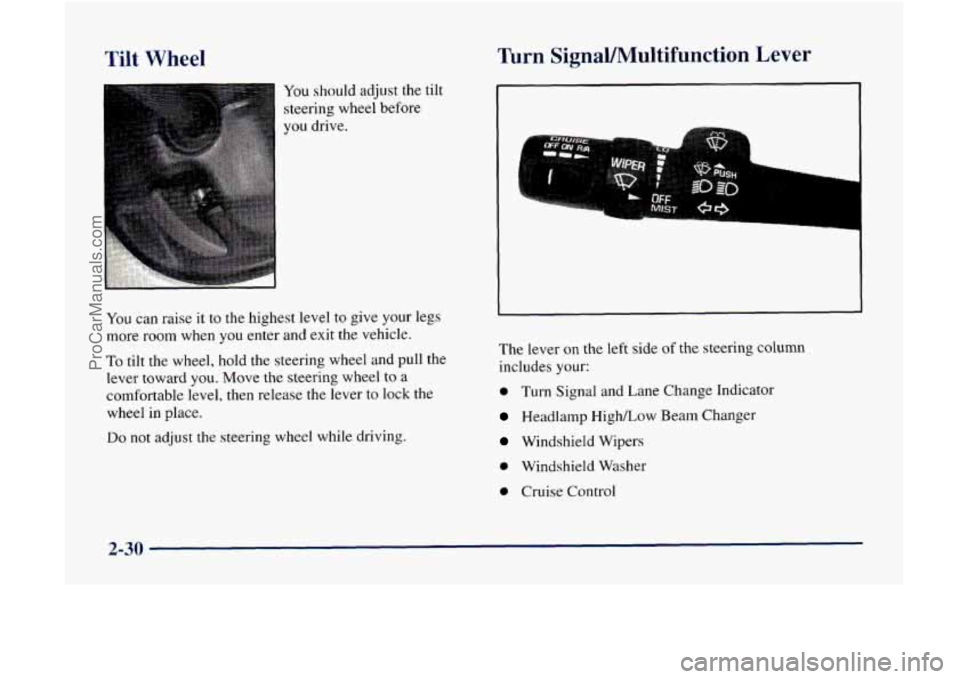
Tilt Wheel
You should adjust the tilt
steering wheel before
you drive.
Turn Signal/Multifunction Lever
You can raise it to the highest level to give your legs
more room when
you enter and exit the vehicle.
To tilt the wheel, hold the steering wheel and pull the
lever toward
YOU. Move the steering wheel to a
comfortable level, then release the lever to lock the
wheel in place.
Do not adjust the steering wheel while driving. The
lever on the left side
of the steering column
includes your:
0 Turn Signal and Lane Change Indicator
Headlamp High/Low Beam Changer
Windshield Wipers
0 Windshield Washer
0 Cruise Control
2-30
ProCarManuals.com
Page 92 of 386
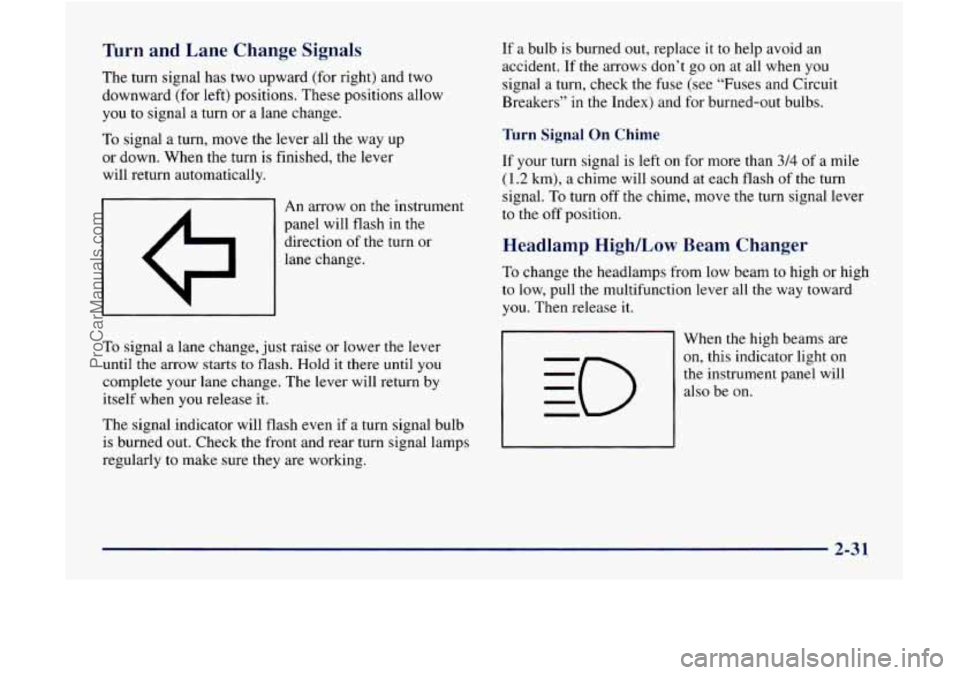
Turn and Lane Change Signals
The turn signal has two upward (for right) and two
downward (for left) positions. These positions allow
you to signal a turn or a lane change.
To signal a turn, move the lever all the way up
or down. When the turn
is finished, the lever
will return automatically.
I 1 I An arrow on the instrument
panel will flash
in the
direction of the turn or
lane change.
To signal a lane change, just raise or lower the lever
until the arrow starts to flash. Hold it there until you
complete your lane change. The lever will return by
itself when you release it.
The signal indicator will flash even if a turn signal bulb
is burned out. Check the front and rear turn signal lamps
regularly
to make sure they are working. If
a bulb is burned out, replace it to help avoid an
accident. If the
arrows don’t go on at all when you
signal a turn, check the fuse (see “Fuses and Circuit
Breakers”
in the Index) and for burned-out bulbs.
Turn Signal On Chime
If your turn signal is left on for more than 3/4 of a mile
(1.2 km), a chime will sound at each flash of the turn
signal.
To turn off the chime, move the turn signal lever
to the off position.
Headlamp High/Low Beam Changer
To change the headlamps from low beam to high or high
to low, pull the multifunction lever all the way toward
you. Then release
it.
When the high beams are
on, this indicator light on
the instrument panel will
also be on.
2-31
ProCarManuals.com
Page 93 of 386

Windshield Wipers
You control the windshield wipers by turning the band
with the wiper symbol on
it.
For a single wiping cycle, turn the band to MIST. Hold
it there until the wipers start, then let go. The wipers will
stop after one wipe. If you want more wipes, hold the
band on
MIST longer.
You can set the wiper speed for a long or short delay
between wipes. This
can be very useful in light rain or
snow. Turn the band to choose the delay time. The
closer to
LO, the shorter the delay. For steady wiping at
low speed, turn the band away
from you to the
LO position. For high-speed wiping,
turn the band further,
to HI. To stop the wipers, move
the band
to the OFF position.
Be sure to clear ice and snow from the wiper blades
before using them.
If they’re frozen to the windshield,
carefully loosen
or thaw them. If your blades do become
worn or damaged, get new blades or blade inserts.
Windshield Washer
There is a paddle marked with the windshield washer
symbol at the top
of the multifunction lever. To spray
washer fluid on the windshield, push the paddle. The
wipers
will clear the window and then either stop or
return to your preset speed.
In freezing weather, don’t use your washer until
the windshield is warmed. Otherwise the washer
fluid can
form ice on the windshield, blocking
your vision.
2-32
ProCarManuals.com
Page 94 of 386
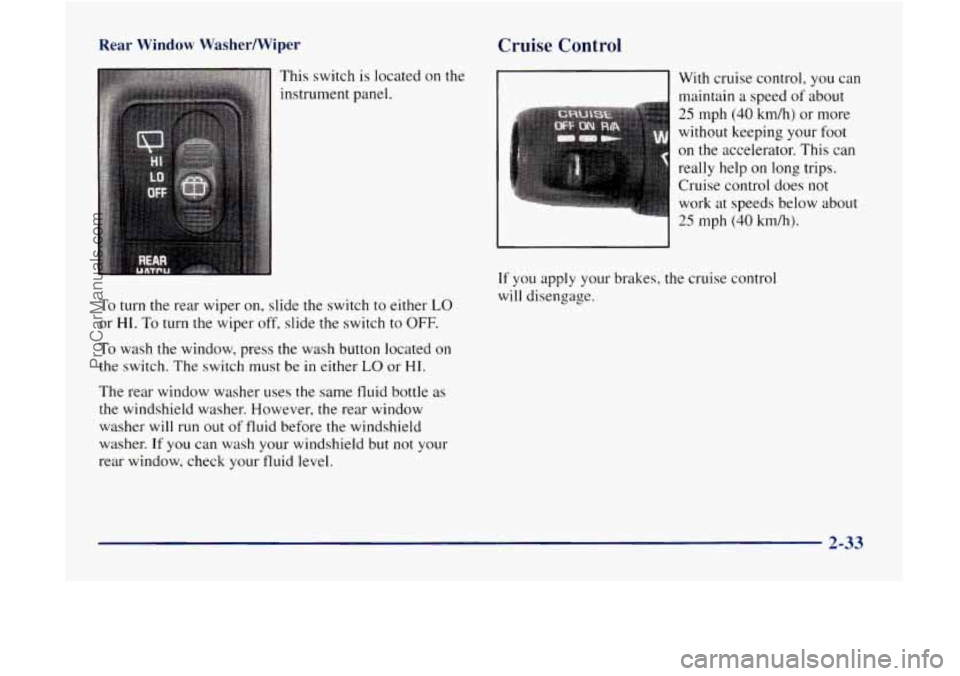
Rear Window Washermiper
To turn the rear wiper on, slide the switch to either LO
or HI. To turn the wiper off, slide the switch to OFF.
To wash the window, press the wash button located on
the switch.
The switch must be in either LO or HI.
The rear window washer uses the same fluid bottle as
the windshield washer. However, the rear window
washer will run out of fluid before the windshield
washer.
If you can wash your windshield but not your
rear window, check your fluid level.
Cruise Control
With cruise control, you can
maintain a speed
of about
25 mph (40 km/h) or more
without keeping your foot
on the accelerator. This can
really help on long trips.
Cruise control does not
work at speeds below about
25 mph (40 kmh).
If you apply your brakes, the cruise control
will disengage.
2-33
ProCarManuals.com
Page 95 of 386
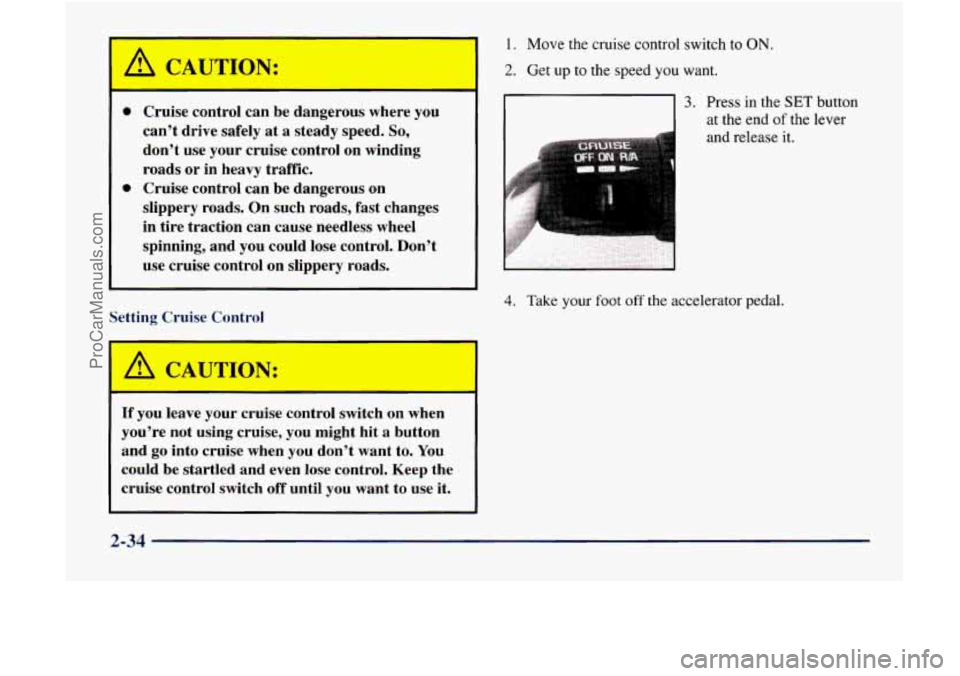
CAUTION:
0
0
Cruise control can be dangerous where you
can’t drive safely
at a steady speed. So,
don’t use your cruise control on winding
roads
or in heavy traffic.
Cruise control can be dangerous on
slippery roads. On such roads, fast changes
in tire traction can cause needless wheel
spinning, and you could lose control. Don’t
use cruise control on slippery roads.
I ,A CAUTION: I
If you leave your cruise control switch on when
you’re not using cruise, you might hit a button
and go into cruise when
you don’t want to. You
could be startled and even lose control. Keep the
cruise control switch off until you want to use it.
1. Move the cruise control switch to ON.
2. Get up to the speed you want.
3. Press in the SET button
at
the end of the lever
and release it.
4. Take your foot off the accelerator pedal.
2-34
ProCarManuals.com
Page 96 of 386
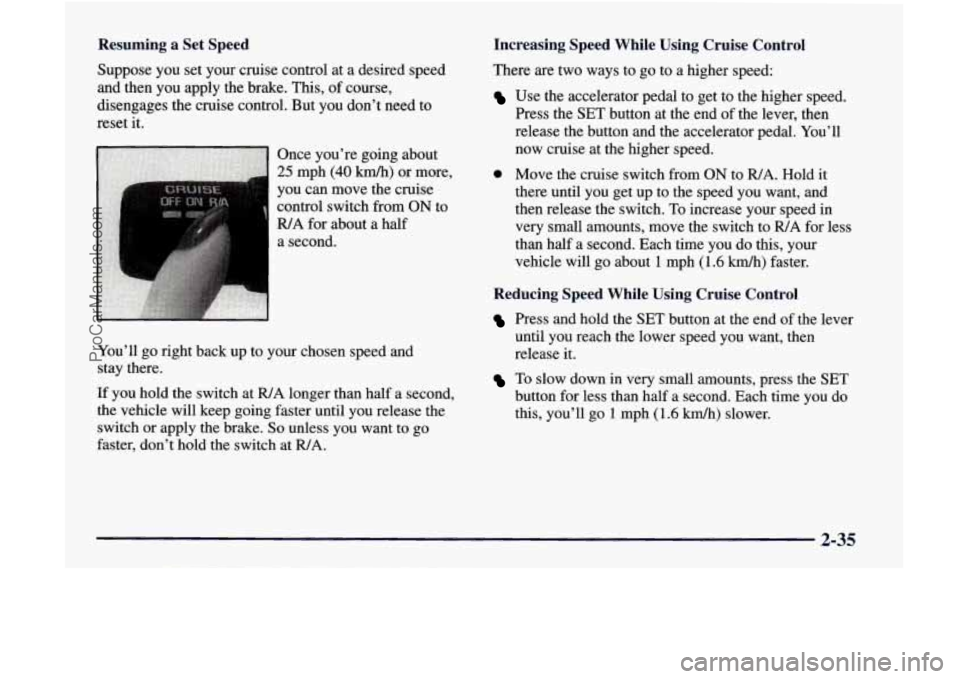
Resuming a Set Speed
Suppose you set your cruise control at a desired speed
and then you apply the brake. This, of course,
disengages the cruise control. But you don’t need to
reset it.
Once you’re going about
25 mph (40 km/h) or more,
you can move the cruise
control switch from
ON to
R/A for about a half
a second.
You’ll go right back up to your chosen speed and stay there.
If you hold the switch at FUA longer than half a second,
the vehicle will keep going faster until you release the switch or apply the brake.
So unless you want to go
faster, don’t hold the switch at
R/A.
Increasing Speed While Using Cruise Control
There are two ways to go to a higher speed:
Use the accelerator pedal to get to the higher speed.
Press the SET button at the end
of the lever, then
release the button and the accelerator pedal. You’ll now cruise at the higher speed.
0 Move the cruise switch from ON to FUA. Hold it
there until you get up to the speed you want, and
then release the switch. To increase your speed in
very small amounts, move the switch to
R/A for less
than half a second. Each time you do this, your
vehicle will go about
1 mph (1.6 km/h) faster.
Reducing Speed While Using Cruise Control
Press and hold the SET button at the end of the lever
until you reach the lower speed you want, then release it.
To slow down in very small amounts, press the SET
button for less than half a second. Each time you do this, you’ll go
1 mph (1.6 km/h) slower.
2-35
ProCarManuals.com
Page 97 of 386

Passing Another Vehicle While Using Cruise Control Exterior Lamps
Use the accelerator pedal to increase your speed. When
you take your foot off the pedal, your vehicle will slow
down to the cruise control speed you set earlier.
Using Cruise Control on Hills
How well your cruise control will work on hills depends
upon your speed, load and the steepness of the hills.
When going up steep hills, you may want
to step on the
accelerator pedal to maintain your speed. When going
downhill, you may have to brake or shift to a lower gear
to keep your speed down.
Of course, applying the brake
takes you out of cruise control. Many drivers find this to
be too much trouble and don’t use cruise control on
steep hills.
Ending Cruise Control
There are two ways to turn off the cruise control:
Step lightly on the brake pedal.
Move the cruise control switch to OFF.
Erasing Speed Memory
When you turn off the cruise control or the ignition,
your cruise control set speed memory is erased. Your
parking lamp and headlamp switch is on the
driver’s side
of your instrument panel.
Rotate the
knob to the right to the parking lamps symbol
to manually turn on:
Parking Lamps
Sidemarker Lamps
Taillamps
License Plate Lamps
Instrument Panel Lights
2-36
ProCarManuals.com
Page 98 of 386

Rotate the knob to the right to the master lamps symbol
to turn on all the lamps listed as well as
the headlamps.
Rotate the
knob all the way to the left to turn off your
lamps and put the system in automatic headlamp mode.
Automatic Headlamp System
When it is dark enough outside, your automatic
headlamp system will turn on your headlamps at the
normal brightness along with other lamps such as the
taillamps, sidemarker, parking lamps and the instrument
panel lights. The radio lights will also be dim.
Your vehicle is equipped with High Intensity Discharge
(€€ID) headlamps. Your headlamps come on at lower
intensity and gradually increase to full brightness.
Your vehicle is equipped with
a light sensor on the top
of the instrument panel under the radio speaker grille,
so
be sure it is not covered, which will cause the system to
be on whenever the ignition is on.
The system may also turn on your headlamps when
driving through a parking garage, heavy overcast
weather, a tunnel or fueling your vehicle in a low-light
area. This is normal.
There is a delay in the transition between the daytime
and nighttime operation of the Daytime Running Lamps
(DRL) and the automatic headlamp systems
so that driving under bridges or bright overhead street lights
does not affect the system. The DRL and automatic
headlamp system will only be affected when the light
sensor
sees a change in lighting lasting longer than
the delay.
To idle your vehicle with the automatic headlamp
system
off, set the parking brake while the ignition is
off. Then start your vehicle. The automatic headlamp
system will stay off until you release the parking brake.
As with any vehicle, you should turn on the regular
headlamp system when you need it.
Lamps On Reminder
A reminder chime will sound when your headlamps or
parking lamps
are manually turned on and your ignition
is in
OFF, LOCK or ACCESSORY. To disable the
chime, rotate the thumb wheel all the way down. In
the
automatic mode, the headlamps turn off once the
ignition key is in
OFF,
Daytime Running Lamps
Daytime Running Lamps (DRL) can make it easier for
others to see the front of your vehicle during the day.
DRL can be helpful in many different driving
conditions, but they can be especially helpful in the short periods after dawn and before sunset.
2-37
ProCarManuals.com
Page 99 of 386

The DRL system will make your high-beam headlamps
come
on at reduced brightness when:
Fog Lamps
the ignition is on,
the headlamp switch is in automatic headlamp
mode and
the parking brake is released.
When the DRL are on, only your high-beam headlamps
will be on. The taillamps, sidemarker and other lamps
won’t be on. The instrument panel won’t be lit up either.
When it begins to get dark, the high-beam headlamps
will automatically switch from DRL to the regular
low-beam headlamps.
When you turn
the headlamp switch off, the regular
low-beam headlamps will
go off, and your high-beam
headlamps will change to the reduced brightness
of DRL
provided it is not dark outside.
To idle your vehicle with
the DRL off, set the parking
brake. The DRL will stay off until
you release the
parking brake.
As with any vehicle, you should turn on the regular
headlamp system
when you need it. Use your fog lamps
for better vision in foggy or misty
conditions. Your low-beam headlamps or your parking
lamps must be on for your fog lamps to work.
The fog lamp switch is
on the instrument panel under
the lamps switch. Press
the switch to turn the fog lamps
on. Press the switch again to turn them
off. A light will
glow in
the switch when the fog lamps are on.
Remember,
fog lamps alone will not give off as much
light as your headlamps. Never use your fog lamps in
the dark without turning on your headlamps.
The
fog lamps will go off whenever your high-beam
headlamps come on. When the high beams
go off, the
fog lamps will come on again.
2-38
ProCarManuals.com
Page 100 of 386

Interior Lamps
Brightness Control
Rotate the thumbwheel next to the headlamp switch up
to make your instrument panel lights brighter. Turn the
switch all the way up to turn
on the interior lamps.
Front Reading Lamp?
Press the button near each lamp on the overhead console
to turn the reading lamps
on and off. The lamps can be
swiveled to point in the desired direction.
If you have the
mini console, press the lens on each
lamp
to turn it on or off.
Exit Lighting
With exit lighting, the interior lamps will come on when
you remove
the key from the ignition. These lights will
stay
on for a short period of time and then will go out.
Illuminated Entry
Your vehicle is equipped with an illuminated entry feature.
When the doors are opened, the dome lamps will come
on if the DOME OVERRIDE button is out. When all the
doors are closed, or the front door handles are lifted and
released, the lamps will stay
on for a short period of
time and will then go
out. If the dome lamp button is
pressed in, the lamps will
go out immediately.
Dome Lamps
The dome lamps will come on when you open the doors.
You can
also turn the dome lamps on by rotating the
thumbwheel, located next to the parking/headlamps
knob, all the way
LIP. In this position, the dome lamps
will remain on whether the doors are opened or closed.
2-39
ProCarManuals.com